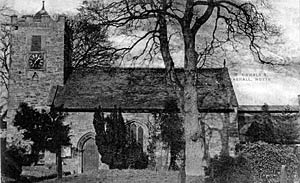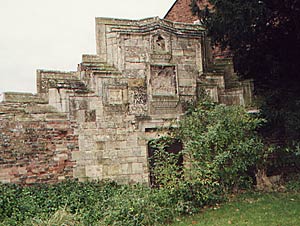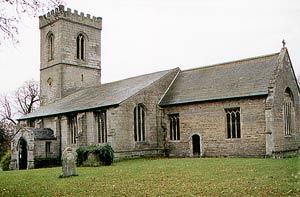< Previous | Contents | Next >
Next Door to Lincolnshire

Ragnall church, c.1905.
RAGNALL. The Trent divides from Lincolnshire this small place looking from a gentle slope to the low hills across the valley. Its neat stone church, much restored, nestles among great trees—yews and sycamores, a splendid walnut, and an ash topping the embattled tower.
There are pleasing windows of the 14th and 15th century still here, and in the little gallery of sculptures adorning them are a woman in a wimple, a praying angel, a knight with a shield, and the bust of a lady in a headdress. The font has roses in quatrefoils. One of two elaborate 17th century wall monuments is to William Reason; the other is to William Mellish, a London merchant who was brought to this village to lie with his wife.
Families of Fame

16th century gateway at Rampton in 2001.
RAMPTON. Over a mile from the Trent, beyond which is Lincolnshire, are its cheery red houses with bright pantile roofs, the old church with something of Saxon England, and the lovely old gateway reminding us that families famous in the county made this village their home. De Ramptons, Malovels, Stanhopes, Babingtons, Eyres—all have been here.
Nothing is left of the old hall to which the Eyres came in the 17th century, built in the time of Henry the Eighth and pulled down two centuries later when they went to live at Grove. But its fine Tudor gateway, adorned with the Stanhope and Babington arms, still stands at a corner of the churchyard. A 19th century gateway in similar style stands by the wayside, and from it a long avenue leads to the house they built when they came back to the village in the middle of last century. Here, too, the glory is gone; we found the house being turned into flats, and the grounds becoming a wilderness.

Rampton church in 2001.
Fine limes and chestnuts and a great, oak are about the church. Its high tower, looking all the taller for having no buttresses, is 14th century except for its west window, which is 15th, and under its battlements are ballflowers. The medieval porch has two charming windows, a sundial, and two worn figures said to represent an angel carrying a soul to paradise and a demon bearing away a soul lost. The old doorway into the church has heads of a king and queen.
The church's most venerable possession is a strangely crude piscina, a tiny recess formed by overlapping courses of the walling; it is in the north aisle, and is thought to be Saxon. A massive square pillar in this aisle, and some masonry in its north wall, are also believed to be Saxon. This ancient walling was taken from the original north wall of the church when it was pierced by the north arcade about 1290; the south arcade is a century later.
The bowl of the font is Norman, its splendid arcading re-worked at a later time, and it rests on a 15th century pedestal. There are two medieval piscinas, and the south aisle has a tiny peephole to the altar. A pillar almsbox may be 15th century, and the altar table in a chapel is Elizabethan, with a strip of the old chancel screen fixed on to it. The present screen is modern, with beautiful carving of roses, vine, and thistle, and gilded medallions with emblems. A shrine made of timber from HMS Britannia has the names of those who served in the war, and in memory of those who died the east window glows richly with the Crucifixion and figures of St George and St Nicholas. The only other colour in the old windows is the charming glass in memory of Inez Ellis, painted in 1924 by her artist friend; it shows Mary and Jesus, and two kneeling angel children with red, yellow, and gold wings, one with a bunch of lilies, the other with head bowed in prayer.
The chancel walls are lined with memorials of the Eyres, a soldier race who came here when Sir Gervase married the heiress of the Babingtons. He died at his post in the Civil War, defending Newark for Charles, and here he sleeps. We read of him on a monument to Gervase Eyre of 1703, elaborate with urns, cherubs, and heraldry.
Three inscriptions are to three generations; Admiral Sir George Eyre of 1839 who served in the French wars, Sir William Eyre who fought in the Crimea, and Anthony Hardolph Eyre, an only son killed in the Ashanti War. A small brass tablet, held by a child angel, is in memory of the wife of one of the Eyres.
Two floorstones with crosses may be 15th century, and over a doorway outside is a stone medallion to Jacobus Twist, a vicar of Shakespeare's day.
